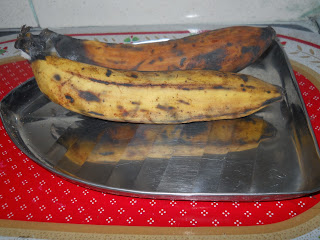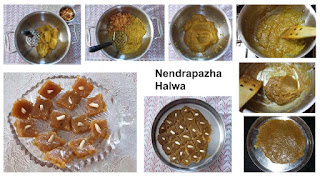Nendrapazham (Kerala plantain) is a favorite with Keralites. It is welcome any time in every household and is relished by the young and the old equally. It is used to make simple snacks for tea-time.

I remember there was a friend of mine who would bring steamed nendrapazham for her lunch (when we were in College, mind you) and I demanded the same from my grandma. But my otherwise adorable granny would not hear of such a frivolous idea! Nendrapazham for a snack was fine - not for lunch! What I want to convey is nendrapazham has been a favorite with my home, then and now!
Keralites prefer eating them steamed! I remember my mother toasting nendrapazham in a 'kori' - a heavy-bottomed iron tava specially set aside for this purpose - oh this 'pazham chuttadu' would be so yummy - we'd patiently peel off the black toasted skin and enjoy the pazham with a topping of ghee and sugar. Those days we hardly cared for 'pazham puzhugiadu' and considered it a poor cousin of the former. But if mom had to cater to a larger crowd / during feasts, she'd steam the pazham pieces with a piece of jaggery and a pinch of salt. That is also called 'pazha nurukku'. My husband would narrate that as a boy, he'd grab a ripe nendrapazham from the nendrakolai (bunch) hanging in the corridor near their bathroom and put it in a 'kozhal' (iron cylinder), close it and shove it in the firewood stove used for heating water - before going for bath. When he'd be out of the bathroom, the toasted pazham would be ready!
I don't toast nendrapazham these days as it is a hassle to clean the tava. I steam them and I have come to relish them too.
My favorite item is the nendrapazha halwa (not exactly a halwa but an evening snack) - a delicacy my mom used to make and we simply loved it. My sons would lap it up too. But when it comes to my grand kids, the parents suggest the 'less sugar, less ghee' item of steamed nendrapazham! Let me begin with this tasty dish.
Nendrapazha Halwa
I make this once in a while as a special item for an evening snack to be consumed the same day or the next.

Ingredients
Nenrapazham ( Kerala Plantain) - 3
Sugar - 4-5 tbsp
Ghee - 2 tbsp
Cardamom powder - 1/2 tsp
Method
Peel the plantains, slit each into half and slice them in thin semicircles.
Heat ghee in a thick-bottomed / non-stick pan.
Add the plantain pieces and fry on medium heat for about five minutes.
Cook covered on low heat for 2 - 3 minutes or till tender.
Add sugar and continue to fry on low heat till it turns a bit brown and crunchy.
Remove from fire and add cardamom powder and mix well.
Serve hot.
Tips
Jaggery can be used instead of sugar.
If the plantains are just ripe, the dish will have the pieces in shape. 
Nendra Pazha Halwa (Pazha varatti)
In case you have a bunch of over-ripe nendrapazham, you can utilize them to make it into halwa to be stored in the fridge for weeks (somewhat like chakka varatti) and also make yummy nendrapazha halwa cut in pieces. Remember they will cook very fast You can cut each into three pieces and steam them for 5-7 minutes and mash them.
Ingredients
Over-ripe Plantains - 3
Powdered Jaggery - 1 cup
Ghee - 2 tbsps
Cardamom powder - 1/2 tsp
Method
Cut each plantain into 3 pieces
Steam them for 5-6 minutes till cooked.
Mash well.
Add 1 cup of powdered jaggery and cook on medium heat
Keep stirring.
Add 2 tbsps of ghee and continue cooking till it leaves the sides of the vessel and rolls into a ball - to make into halwa form. This can be stored in the fridge for a month. This can be used to make 'nendrapazha pradhaman' on the lines of 'chakka pradhaman'. My sister-in-law had served us ice cream with this warmed halwa and it was really yummy.
Nedrapazha Halwa Squares
If you continue to cook, adding a little more ghee, you can pour the thick ball on to a greased plate and flatten it with a greased ladle. After 5 minutes, draw lines with a greased knife to form squares. Press an almond slice on top of each square (optional). After 10 minutes, carefully cut out the halwa squares.
Pazham Puzhungiadu / Pazhanurukku

Now let's us get back to the simplest of nendrapazha recipe - 'pazhanurukku' - it is still served as an item during feasts, especially during Onam / Vishu. This is a very easy-to-make and healthy snack for kids as well as adults. This is what I make with nendrazham these days. But some would shy away from this because of its texture and prefer to eat the plantain raw.

 Ingredients
Ingredients
2-3 Nendrapazham (Kerala Plantains)
Method
Cut each plantain into 3 / 4 pieces.
Heat 2 cups of water in a pressure cooker.
Keep the plantain pieces in a steel colander / idli stand and steam them in the pressure cooker without the weight - for 10 minutes (as with idlis).
Remove the skin and enjoy eating!
If you don't count calories, add a dash of ghee and sugar after slitting open each piece - yummy!
They also taste good with a piece of pappadam / banana chips.
Those of you in some parts of the US can get 'plantains' in the US / Chinese grocery stores. You can steam them in the microwave for 11/2 - 2 minutes to make 'pazhanurukku' - avid nendrapazha lovers will miss the little sourness in the US variety, that's all.
.jpg) |
| Microwaved nendrapazham |
Pazhampori
Another recipe with Kerala plantain is 'Pazhampori' (Nendrapazha bajji) available in small cafeterias all over in Kerala. I have posted this dish along with a variety of pakodas in the post 'Bajjis & Pakodas' in my blog cosmokitchen.blogspot.com. This is made by dipping thin slices of ripe Kerala plantains in 'bajji' batter and frying them in oil.
Ingredients
Nendrapazham - 2
For batter
Gram flour (besan) – 1 cup
Rice flour – 1-2 tbsp
Baking powder – a pinch
Red chilli powder – 1 tsp
Coriander powder (optional) – 1 tsp
Asafetida – a pinch
Salt to taste
Hot oil – 1 ½ tsp
Oil for frying
Method
1. In a bowl, mix gram flour, rice flour, baking powder, red chilli powder, asafetida, coriander powder and salt.
2. Add ½ - ¾ cup of water and whisk well for at least 5 minutes to make a fairly thick batter and set aside for 5 minutes. (No big deal about the consistency of the batter - if the batter is thick, then you can enjoy a thickly coated bajji. If the batter is runny, the bajjis will have a thinner covering!)
3. Just before making bajjis, add a tsp of hot oil and mix well – this will add to its crispness.
4. Use 2 big ripe Kerala plantains.
5. Peel and cut the banana in 2 parts.
6. Make slices (5-6) of each half.
7. Dip each slice till fully coated with batter and fry in oil till both sides are golden brown and drain off.
Tips
I mix 1 cup of gram flour, 2 tbsp of dosa batter, red chilli powder, asafetida and salt. Then I add ½ - ¾ cup of water and make a thick batter, blending it well with my hand and set it aside for 10 minutes. There is no need of adding hot oil. My bajjis are fluffy and soft and almost oil-free!
Instead of besan, maida can be used. Just add a pinch of salt and a tsp of sugar to maida and make the batter.
© Copyright 2011. Brinda Balasubramonian.













.jpg)
